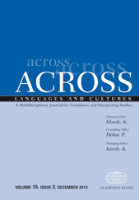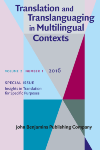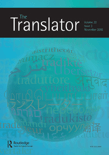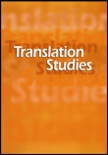
Babel-Revue Internationale de la Traduction-International Journal of Translation
Scope & Guideline
Connecting Scholars and Practitioners in Translation Theory
Introduction
Aims and Scopes
- Interdisciplinary Approaches to Translation:
The journal emphasizes the integration of various disciplines such as linguistics, cultural studies, and technology in translation studies, promoting a holistic understanding of the translation process. - Cultural and Contextual Studies:
A core aim is to explore the cultural implications of translation, including how translation mediates cultural exchange and influences identity, power dynamics, and social justice. - Technological Innovations in Translation:
The journal also focuses on the impact of technology, including machine translation, AI, and digital tools, on the translation profession and practices, highlighting the evolving landscape of translation in the digital age. - Literary Translation and Adaptation:
It addresses the challenges and methodologies in literary translation, including issues of fidelity, creativity, and the role of translators as cultural agents. - Education and Training in Translation:
A significant focus is placed on translator education, exploring pedagogical strategies and competencies necessary for emerging professionals in the field.
Trending and Emerging
- Translation and Social Justice:
There is an increasing focus on the role of translation in social justice, examining how translation practices can empower marginalized voices and influence societal change. - Impact of Artificial Intelligence and Technology:
The integration of AI and machine learning in translation is a growing theme, highlighting both the challenges and opportunities these technologies present for translators and the profession. - Multimodal and Intersemiotic Translation:
Emerging studies are exploring translation beyond text, incorporating a multimodal perspective that includes images, sounds, and other sensory elements, reflecting the complexities of modern communication. - Gender and Translation Studies:
A rising interest in gender perspectives in translation, including feminist translation strategies and the representation of gender in translated texts, is becoming increasingly prominent. - Cultural Translation and Globalization:
The journal is seeing more research on the implications of globalization on translation practices, particularly how cultural nuances are navigated in a globalized world.
Declining or Waning
- Traditional Linguistic Analysis:
Research focused solely on linguistic structures and grammar in translation seems to be waning, with fewer papers engaging deeply with these aspects in isolation, as the field moves toward more integrated and contextual approaches. - Static Translation Norms:
The exploration of fixed translation norms and guidelines appears to be declining, as contemporary studies emphasize the dynamic and context-dependent nature of translation practices. - Historical Translation Studies:
There is a noticeable reduction in papers centered on historical perspectives of translation, suggesting a shift towards contemporary issues and practices rather than examining historical texts and their translations.
Similar Journals

Estudios de Traduccion
Exploring the dynamic landscape of translation research.Estudios de Traduccion is a distinguished academic journal published by UNIV COMPLUTENSE MADRID, SERVICIO PUBLICACIONES, dedicated to advancing the field of translation studies. Since its establishment, the journal has embraced an Open Access model, providing researchers, professionals, and students with free and unrestricted access to high-quality scholarly articles since 2011. With the ISSN 2174-047X and E-ISSN 2254-1756, it serves as a vital resource for those interested in innovative methodologies, theoretical advancements, and practical applications within translation. By championing interdisciplinary research and fostering dialogue among scholars from diverse backgrounds, Estudios de Traduccion plays a crucial role in shaping the understanding of translation as a dynamic and evolving discipline. As a reputable platform, it invites contributions that stimulate critical thought and inspire future research in this essential area of communication.

Across Languages and Cultures
Bridging Cultures Through Linguistic InnovationAcross Languages and Cultures is a leading journal in the field of Linguistics and Language, published by AKADEMIAI KIADO ZRT in Hungary. With its ISSN 1585-1923 and E-ISSN 1588-2519, the journal has established itself as a prominent platform for advancing research and discussion in the dynamics of language across diverse cultural contexts. Its impressive Q1 category ranking indicates its significant influence, with a Scopus rank of #227 in Language and Linguistics, showcasing its robust academic impact (79th percentile). This journal, converging from 2007 to 2024, aims to foster interdisciplinary dialogue and promote innovative research methodologies in multilingual studies. Though not an open-access journal, Across Languages and Cultures provides invaluable insights for researchers, professionals, and students eager to explore the intricacies of language use and its sociocultural implications. Located at Budafoki Ut 187-189-A-3, H-1117 Budapest, Hungary, it continues to serve as an essential resource for those passionate about the linguistic sciences.

Translation and Translanguaging in Multilingual Contexts
Innovating Communication Across Linguistic BordersTranslation and Translanguaging in Multilingual Contexts, published by John Benjamins Publishing Co, is an esteemed academic journal that delves into the intricate relationships between translation practices and translanguaging in diverse linguistic settings. With its ISSN 2352-1805 and E-ISSN 2352-1813, this journal provides a platform for innovative research from 2019 to 2024, focusing on areas that intersect education, linguistics, and literary theory. Notably, it holds prestigious rankings, reflecting its impact and quality; it is classified in Q2 in Education, and Q1 in both Linguistics and Language, and Literature and Literary Theory for 2023. With Scopus rankings that place it in the top deciles of multiple categories, it serves as a vital resource for scholars aiming to explore multilingual communication's challenges and opportunities. Although it operates on a traditional access model, the journal remains a critical reference point for the exchange of ideas that shapes current research in these dynamic fields.

Cadernos de Traducao
Connecting researchers through rigorous peer-reviewed studies.Cadernos de Tradução, published by the Universidade Federal de Santa Catarina, is an esteemed open-access journal dedicated to fostering scholarship in the fields of Language, Linguistics, and Literature. Since its inception in 1996, this journal has emerged as a vital platform for research, particularly known for its rigorous peer-review process and commitment to academic excellence. With a Q2 ranking in Linguistics and Language and a Q1 ranking in Literature and Literary Theory as of 2023, it stands out in the global academic landscape, holding significant positions in Scopus rankings across various categories. Researchers, professionals, and students will find a wealth of interdisciplinary studies that contribute to current discussions and advancements in translation theory and practice. The journal's open-access model enhances visibility, ensuring that groundbreaking research is accessible to a wide audience, thus promoting dialogue and collaboration within the international academic community.

Forum-Revue Internationale d Interpretation et de Traduction-International Journal of Interpretation and Translation
Cultivating Insights into Contemporary Translation Practices.Forum-Revue Internationale d’Interprétation et de Traduction - International Journal of Interpretation and Translation is a prestigious peer-reviewed journal published by John Benjamins Publishing Co, renowned for its contributions to the fields of linguistics and literary theory. With an ISSN of 1598-7647 and an E-ISSN of 2451-909X, this journal provides a vital platform for researchers, professionals, and students to disseminate and engage with innovative research findings and theoretical developments in interpretation and translation studies. As of 2023, it holds a respectable Q3 ranking in Linguistics and Language and a Q2 in Literature and Literary Theory, underscoring its growing influence within academia, reflected by its Scopus rankings. The journal encompasses a diverse array of perspectives and methodologies to enhance the understanding of translation practices and their implications in contemporary society. Although the journal operates within a limited open access framework, its commitment to high-quality scholarship makes it an essential resource for those seeking to contribute to and stay abreast of advancements in this dynamic field. Established to foster interdisciplinary dialogue, the journal invites submission from a wide range of scholarly approaches and encourages collaborative discourse among linguists, translators, and literary theorists.

Translator
Illuminating the Intersection of Language and CultureTranslator is a leading journal in the fields of Communication and Linguistics, dedicated to exploring the complex dynamics of translation through critical analysis and scholarly discourse. Published by Routledge Journals, Taylor & Francis Ltd from the United Kingdom, this journal boasts a significant impact within its academic community, holding a prestigious Q1 ranking in Linguistics and Language and a Q2 ranking in Communication as of 2023. With a strong focus on interdisciplinary studies, it aims to foster an understanding of translation as both a linguistic and culturally significant practice. Researchers and practitioners alike can engage with cutting-edge research and extensive discourse, making it a valuable resource for advancing knowledge in this vital field. The journal spans a remarkable convergence of insights from 1995 to 2024, reflecting its long-standing commitment to academic excellence and innovation. Access to its resources is facilitated through various platforms, ensuring that findings are readily available to the broader academic community.

Germanoslavica-Zeitschrift fur Germano-Slawische Studien
Cultivating Understanding at the Crossroads of CulturesGermanoslavica-Zeitschrift für Germano-Slawische Studien, published by the esteemed SLOVANSKY USTAV AKAD CESKE REPUBLIKY, serves as a pivotal platform for scholarly discourse in the fields of linguistics and literary studies. Since its inception in 2002, this journal has dedicated itself to exploring the intricate relationships between German and Slavic languages and literatures, fostering a greater understanding of this culturally rich intersection. With its publication indexed in Scopus and categorized in the Q4 quartile for Linguistics and Language as well as Literature and Literary Theory, it provides valuable insights at the junction of these disciplines. Although it currently does not have open access options, the journal's commitment to quality research ensures it remains a respected resource for researchers, professionals, and students alike. The journal’s dedication to advancing knowledge makes it an essential reference point for those investigating the complexities of Germano-Slavic interactions.

Translation Studies
Leading the Way in Translation and Interpreting StudiesTranslation Studies is a premier journal in the field of linguistics and language, published by Routledge Journals, Taylor & Francis Ltd, and is recognized for its exceptional impact within the academic community, boasting a Q1 classification in Linguistics and Language as of 2023. With its ISSN 1478-1700 and E-ISSN 1751-2921, this journal serves as an eminent platform for disseminating groundbreaking research, theoretical advancements, and practical applications related to translation and interpreting studies. Covering a comprehensive scope, the journal publishes original research articles, critical reviews, and theoretical discussions, making significant contributions to both the arts and humanities as well as social sciences. The journal is published in the United Kingdom and has maintained a solid reputation from its inception in 2008 through to 2024. Positioned within the top ranks of Scopus in both the language and linguistics categories, it ensures visibility, making it an essential resource for scholars, practitioners, and students who wish to stay informed of the latest trends, methodologies, and discussions in translation studies.

Bible Translator
Advancing Understanding of Scripture Across LanguagesThe Bible Translator is a distinguished journal dedicated to the scholarly exploration and analysis of biblical translations and their impact across cultures and traditions. Published by SAGE Publications Ltd, this journal seeks to bridge the gap between theology, linguistics, and intercultural communication, providing an essential platform for researchers, translators, and educators alike. With an ISSN of 2051-6770 and an E-ISSN of 2051-6789, it ensures broad accessibility to its readership. Although it currently does not operate under an Open Access model, the journal's rigorous peer-review process and commitment to high-quality research make it a vital resource for professionals and students in the fields of religious studies and translation theory. Contributing to the ongoing discourse around scriptural texts, The Bible Translator remains pivotal in fostering understanding and appreciation of the intricacies involved in translating sacred writings, thereby reinforcing its importance in both academic and applied contexts.

Trans-Revista de Traductologia
Fostering Global Scholarship in Translation PracticesTrans-Revista de Traductologia, an esteemed journal in the realm of Translation Studies and Linguistics, is published by the University of Malaga's Faculty of Philosophy and Letters. With an Open Access model since 2015, it facilitates the global dissemination of research and findings, supporting the academic community and enhancing visibility for scholars. The journal spans research from 2012 to 2023 and has achieved a commendable Q2 ranking in the Linguistics and Language category for 2023, signifying its growing influence within the field. Its Scopus rankings reflect its competitive edge, positioned at #484 in Arts and Humanities as well as #565 in Social Sciences, as it continues to foster a platform for innovative and interdisciplinary investigation in language dynamics, translation practices, and cultural exchanges. Scholars, professionals, and students alike will find a rich resource within its pages to explore both theoretical frameworks and practical applications in translation.